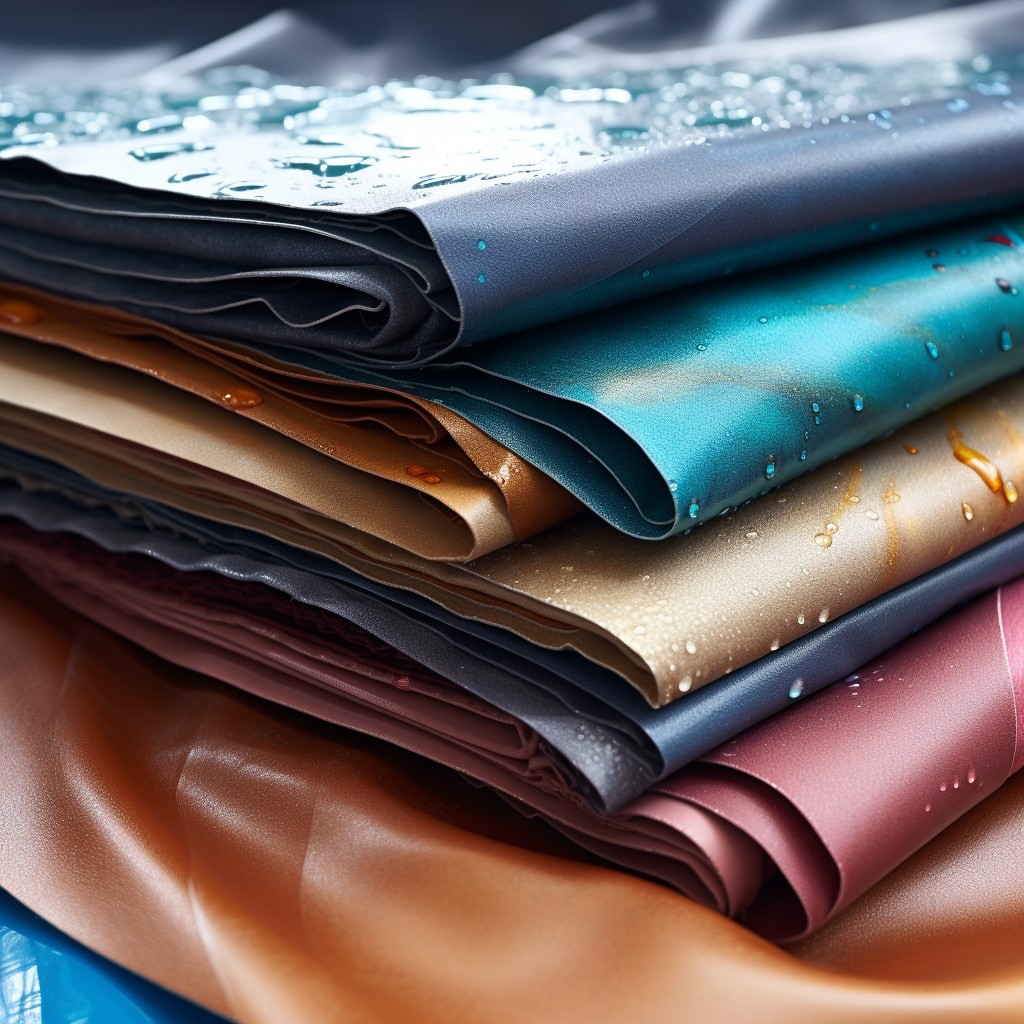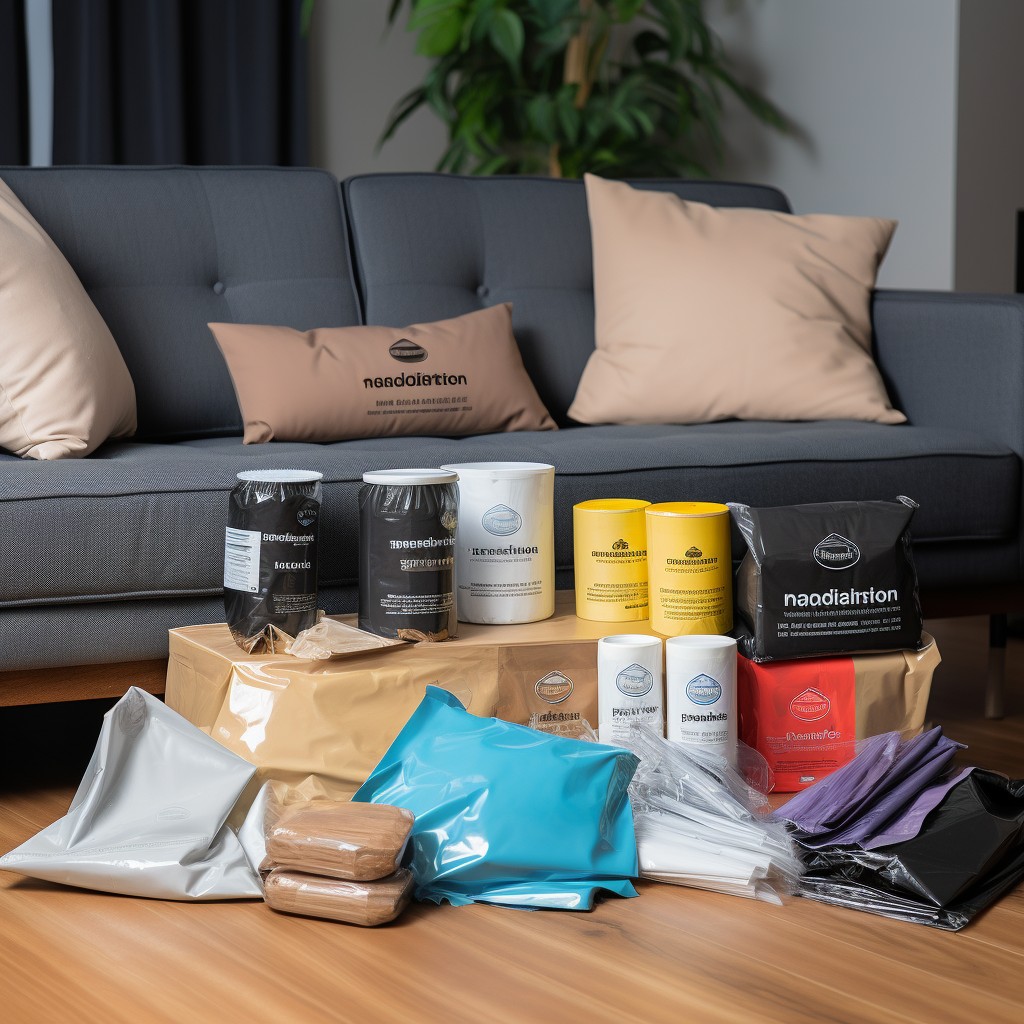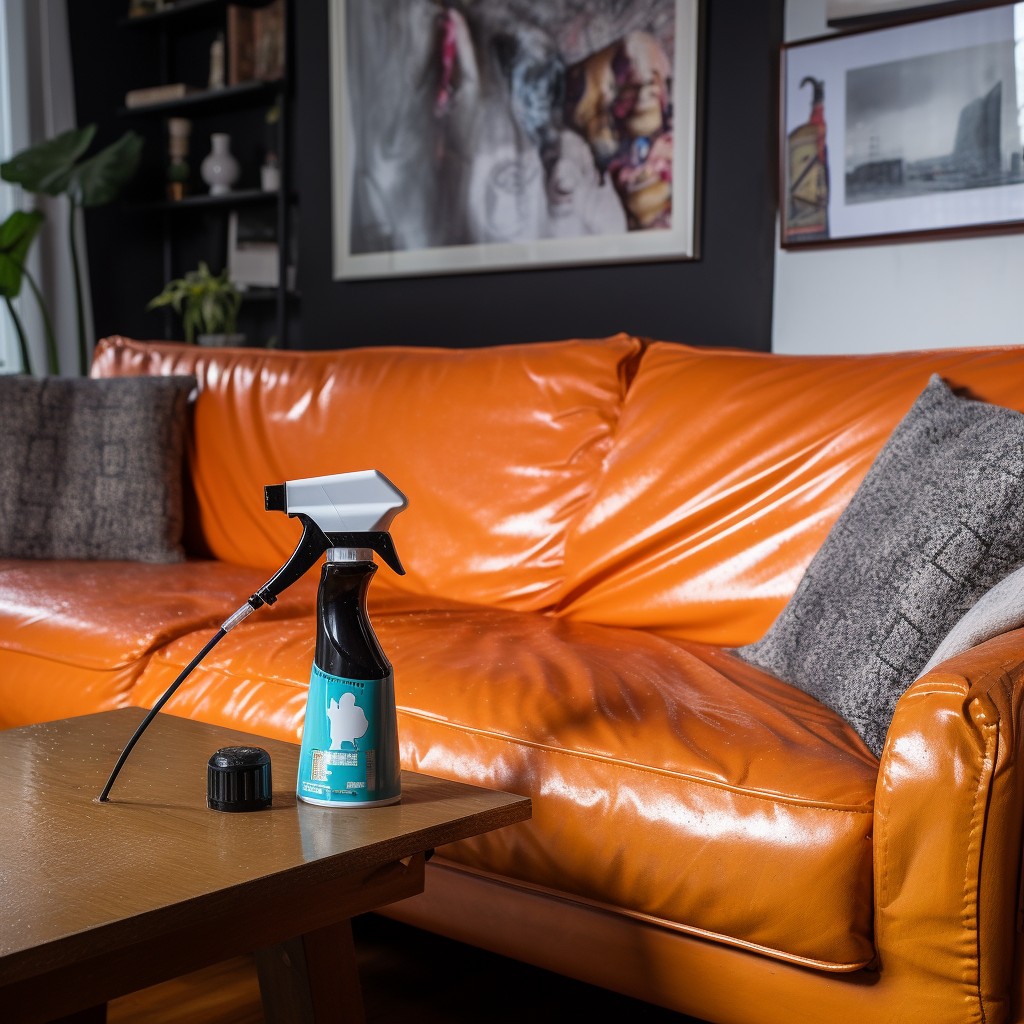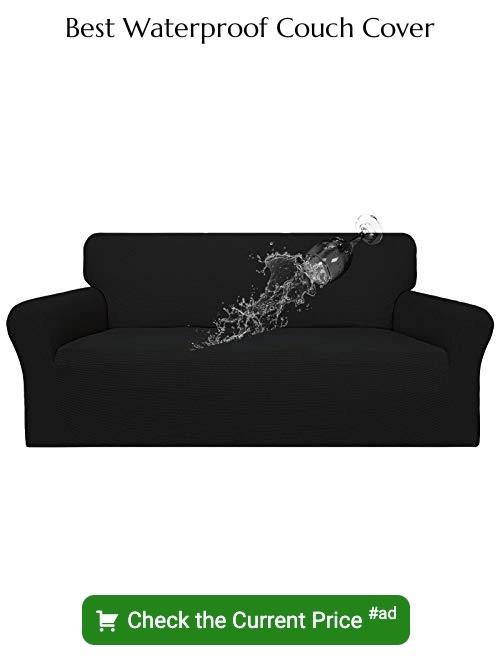Last updated on
Discover the simple steps to effectively waterproof your couch, ensuring its longevity and protection against accidental spills or stains.
Are you tired of constantly worrying about spills and stains on your couch? Do you want to protect your furniture from water damage? Look no further, as we have the solution for you! In this article, we will guide you through the process of waterproofing your couch. Whether it’s a leather or fabric sofa, we’ve got you covered.
So sit back, relax, and let us show you how to keep your couch looking brand new for years to come.
Table of Contents
Choose the Right Fabric

The first step in waterproofing your couch is to choose the right fabric. Some fabrics are naturally more water-resistant than others, such as leather or vinyl.
However, if you have a fabric couch that needs protection against spills and stains, there are several options available.
When choosing a fabric for your couch, look for materials that repel water or have been treated with a protective coating. Microfiber and synthetic fabrics like polyester and nylon can be good choices because they tend to resist moisture better than natural fibers like cotton or linen.
It’s also important to consider the color of your sofa when selecting a waterproofing method. Darker colors tend to hide stains better than lighter shades but may fade over time with exposure to sunlight.
Types of Waterproofing Materials

The most common ones include silicone-based sprays, wax-based coatings, and polyurethane sealants. Each material has its own unique properties that make it suitable for different types of fabrics and situations.
Silicone-based sprays are ideal for leather or vinyl couches as they provide a protective layer without altering the texture or color of the fabric. Wax-based coatings work well on cotton or linen fabrics as they create a barrier against water while still allowing air to circulate through the fibers.
Polyurethane sealants are perfect for outdoor furniture made from wood or metal frames with cushions covered in polyester fabric. They offer excellent protection against moisture and UV rays while also providing an extra layer of durability.
Choosing the right type of waterproofing material is crucial in ensuring that your couch remains protected from spills and stains without compromising its appearance or comfort level.
Waterproof Spray Selection

There are many different types of waterproof sprays available on the market, each with its own unique features and benefits. Some sprays are designed specifically for leather or suede materials, while others work best on fabric upholstery.
Before purchasing a spray, consider factors such as durability and effectiveness against water damage. It’s also important to choose a product that won’t alter the appearance or texture of your couch material.
One popular option is Scotchgard Fabric & Upholstery Protector Spray. This versatile spray can be used on various fabrics and provides long-lasting protection against spills and stains without changing their look or feel.
Another great choice is Rust-Oleum NeverWet Outdoor Fabric Spray which creates an invisible barrier that repels liquids from outdoor furniture cushions making them resistant to rain showers so you don’t have to worry about bringing them inside every time there’s a chance of rain.
Ultimately, choosing the right waterproofing spray will depend on your specific needs and preferences as well as what type of material you’re working with.
Choosing the Right Waterproofing Method

The right method for you will depend on the type of fabric or material your couch is made of and how much protection you need.
One popular option is using a waterproof spray, which creates an invisible barrier that repels water and stains. This method works well for most fabrics but may not be suitable for leather or suede materials.
Another option is applying a waterproof coating directly onto the surface of your couch. This involves using a brush or roller to apply the coating evenly over every inch of fabric, ensuring complete coverage.
If you’re looking for long-term protection against spills and stains, slipcovers are also an excellent choice. Slipcovers come in various materials such as vinyl or plastic that provide full coverage while still allowing air circulation around cushions.
Surface Preparation
Surface preparation ensures that the waterproof spray adheres correctly and provides maximum protection against water damage.
Start by removing any dust or debris from your couch using a soft-bristled brush or vacuum cleaner. Next, use a mild detergent solution to clean any stains on the fabric or leather surface of your sofa.
Make sure to rinse thoroughly with clean water and let it dry completely before proceeding.
If there are any cracks in the leather upholstery, fill them with an appropriate filler material before applying waterproof spray. For fabric sofas, check for loose threads and repair them if necessary.
Preparing Your Couch for Waterproofing
This will ensure that the waterproof spray adheres well and provides maximum protection against spills and stains.
Firstly, remove any cushions or pillows from your couch. This will allow you to access all areas of the sofa easily.
Next, vacuum any loose dirt or debris from the surface of your couch using a soft brush attachment.
If there are any visible stains on your sofa, use a mild detergent solution to clean them off before proceeding with waterproofing. Make sure that all cleaning agents are completely removed by wiping down with water and allowing it to dry thoroughly.
Cover any non-removable parts such as legs or armrests with plastic wrap or painter’s tape so they don’t get sprayed accidentally during application.
Waterproofing With Scotch Guard
It creates an invisible barrier on the surface of the fabric, making it resistant to spills and stains. To use Scotch Guard, start by cleaning your couch thoroughly with a vacuum cleaner or upholstery cleaner.
Make sure there are no dirt or dust particles left on the surface before applying the spray.
Next, shake the can well and hold it about 6 inches away from your couch’s surface. Spray evenly in a sweeping motion until you have covered all areas that need protection.
Allow time for drying as per instructions provided by Scotch Guard manufacturer before using your sofa again. It is important to note that while Scotch Guard provides excellent protection against water damage, it may not completely prevent staining if spills are not cleaned up promptly.
Waterproofing with Scotch Guard is an effective way to protect your couch from accidental spills and stains without altering its appearance or texture significantly.
Spray Application Process
The application process is relatively simple and can be done in a few easy steps.
Firstly, make sure that the area where you will be applying the spray is well-ventilated. Open windows or doors if necessary to ensure proper air circulation.
Next, shake the can of waterproofing spray thoroughly before use. Hold it about 6 inches away from your couch and begin spraying evenly across all surfaces of your furniture piece.
Make sure not to oversaturate any one area as this may cause discoloration or damage to certain fabrics such as leather or suede. It’s best practice to work in small sections at a time until you’ve covered every inch of your couch with an even coat of waterproofing material.
After completing each section, allow ample drying time before moving on to another part of the sofa – usually around 24 hours should suffice but check manufacturer instructions for specific guidance on drying times based on humidity levels etcetera.
Applying Waterproof Spray
Before starting, make sure that the surface is clean and dry. You can use a vacuum cleaner or a soft brush to remove any dust or debris from your couch.
When applying the waterproof spray, hold the can about 6-8 inches away from the surface of your couch and start spraying in even strokes. Make sure that you cover every inch of fabric with an even layer of spray.
It’s important not to oversaturate any one area as this may cause discoloration or damage to certain fabrics such as leather. If necessary, repeat this process until you achieve full coverage on all surfaces.
After applying waterproofing spray on all areas of your sofa let it dry completely before using again (usually takes around 24 hours). Once dried up check if there are still some spots left uncovered by repeating these steps until everything is covered evenly without leaving wet patches behind.
Drying Time
The drying time can vary depending on the type of fabric and the amount of spray used. Generally, most waterproof sprays require at least 24 hours before they are fully dried and effective.
During this period, avoid sitting or placing any objects on your couch as this may cause damage or leave marks on its surface. It’s also essential that you keep pets away from your furniture during this period as their fur can stick onto wet surfaces.
To ensure that your couch is thoroughly dry before use, check for any dampness by touching different areas with a clean cloth after 24 hours have passed since application. If there are still signs of moisture present in some areas, give them more time to air out until they’re completely dry.
Additional Waterproof Coating
This can be done by applying a waterproof coating over the sprayed surface. A clear polyurethane or acrylic sealer is ideal for this purpose as it will provide an extra barrier against water and stains.
To apply the coating, simply follow the instructions on its packaging. Make sure that your couch is completely dry before starting this process.
Use a clean brush or roller to apply a thin layer of sealant evenly over all surfaces of your couch.
Allow each coat to dry completely before applying another one if necessary. Depending on how much use your couch gets, you may need to reapply this protective coating every few months.
Slipcovers for Protection
Slipcovers come in various materials, including cotton, polyester, and microfiber. They can be easily removed and washed when needed.
When selecting a slipcover for your couch, make sure it fits properly to avoid any bunching or slipping. You can also choose from different colors or patterns that complement your home decor.
Slipcovers not only provide protection but also add an extra layer of comfort to your couch. They are perfect for households with children or pets as they offer an additional barrier against accidents.
However, keep in mind that slipcovers may not be completely waterproof on their own and should still be used in conjunction with other protective measures such as waterproof sprays or coatings.
How to Use a Waterproof Couch Cover
These covers are designed to fit snugly over your furniture and provide an additional layer of protection against spills and stains. They come in various sizes, colors, and materials such as vinyl or polyester.
To use a waterproof couch cover effectively, start by selecting the right size for your sofa or chair. Make sure it fits securely without any loose areas that could allow liquids to seep through.
Once you have the correct size cover, place it over the entire surface of your couch. Tuck any excess material into crevices between cushions or along the sides of arms if necessary.
It’s important to note that while these covers can protect against spills and stains on top of them; they do not guarantee complete protection from water damage underneath them if there is already moisture present on the surface before placing them down.
Waterproofing Indoor Cushions
Indoor cushions are often made of materials that can easily absorb water and stains, making them difficult to clean. To waterproof indoor cushions, you can use a spray-on fabric protector or apply a waterproof coating.
Before applying any product to your cushion, make sure it is clean and dry. You don’t want any dirt or debris getting trapped under the protective layer.
Once the cushion is ready for application, follow the instructions on your chosen product carefully. Spray evenly over the surface of each cushion until they are fully covered with an even coat of protection.
Allow ample time for drying before using again – this will ensure that no moisture gets trapped inside which could lead to mold growth or other issues down the line.
Caring for Waterproof Couch
Regular cleaning and maintenance will help prolong the life of your furniture and ensure that it remains waterproof.
To clean a waterproof couch, simply wipe down any spills or stains with a damp cloth as soon as possible. Avoid using harsh chemicals or abrasive cleaners that can damage the fabric or coating.
It’s also important to periodically reapply the waterproofing spray every six months to one year depending on usage. This will help maintain its effectiveness against water damage.
Consider investing in slipcovers for added protection against spills and stains. These covers are easy to remove and wash when needed, keeping your couch looking fresh for longer periods of time.
Tips for Maintaining Waterproof Couch
Here are some tips for maintaining a waterproof couch:
1. Clean spills immediately: Even though your couch is now waterproof, it’s still important to clean up any spills or stains as soon as possible.
2. Avoid harsh chemicals: When cleaning your couch, avoid using harsh chemicals that can damage the fabric or coating.
3. Use a soft brush attachment when vacuuming: This will help prevent any damage to the surface of the fabric and keep it looking new.
4. Reapply periodically: Over time, the effectiveness of the waterproof coating may wear off due to regular use and exposure to sunlight and other elements; therefore periodic reapplication may be necessary.
Periodic Re-application
Therefore, periodic re-application is necessary to maintain its protective properties. The frequency of re-application depends on various factors such as usage and exposure to elements like sunlight and humidity.
As a general rule, it’s recommended that you reapply waterproofing spray every six months for optimal protection against spills and stains. However, if your couch experiences heavy use or frequent exposure to moisture or direct sunlight, then more frequent applications may be necessary.
To ensure maximum effectiveness when applying a new coat of waterproofing spray on your couch surface; make sure you clean any dirt or debris from the surface before spraying again. This will help prevent any buildup which can affect how well future coatings adhere.
Outdoor Couch Material Options
Outdoor furniture is exposed to harsh weather conditions and needs durable materials that can withstand moisture and UV rays. Some of the best options for outdoor couches include synthetic wicker, aluminum, teak wood or resin-based materials.
Synthetic wicker is a popular choice as it looks like natural rattan but is more resistant to water damage. Aluminum frames are lightweight and rust-resistant making them ideal for outdoor use.
Teak wood has natural oils that make it resistant to water damage while also giving your furniture a classic look.
Resin-based materials such as polyethylene (PE) or polypropylene (PP) are also great choices for waterproofing your outdoor couches due their durability against extreme weather conditions.
Dealing With Spills
There are ways to deal with them effectively without causing any damage to your furniture. The first step is to act quickly by blotting the spill as soon as possible using a clean cloth or paper towel.
Avoid rubbing the stain as this will only spread it further.
For liquid spills, use a dry cloth or paper towel first before applying any cleaning solution. For food stains, gently scrape off any solid particles using a spoon or knife before treating the area with an appropriate cleaner.
It’s important not to use harsh chemicals on your waterproofed couch as they may strip away its protective coating and cause discoloration over time. Instead, opt for mild cleaners that are specifically designed for upholstery fabrics.
Maintaining Waterproof Effectiveness
Regular maintenance will ensure that the protective coating remains intact and continues to repel water effectively. Here are some tips for maintaining the waterproofing of your couch:
1. Clean spills immediately: Even though your couch is now waterproof, it’s still important to clean up any spills as soon as possible.
2. Avoid harsh chemicals: Harsh cleaning chemicals can damage the protective coating on your couch and reduce its effectiveness.
3. Use a soft brush or cloth: When cleaning or wiping down your sofa, use a soft brush or cloth instead of abrasive materials that could scratch off the protective layer.
4. Reapply periodically: Over time, even with proper care and maintenance, the waterproofing on your sofa may wear off due to regular use and exposure to sunlight; therefore periodic reapplication may be necessary.
By following these simple steps regularly after applying a coat of water-resistant spray on furniture like sofas/chairs/cushions etc., you can keep them looking new for years while protecting them from accidental spills/stains/damage caused by moisture/water!
FAQ
Can you make a fabric couch waterproof?
Yes, you can make a fabric couch waterproof by using store-bought silicone solutions or applying wax as a sealant.
Can you turn an indoor couch into an outdoor couch?
Yes, you can turn an indoor couch into an outdoor couch by choosing an outdoor-friendly fabric and redoing the piece to withstand the elements.
Can you spray fabric to make it waterproof?
Yes, fabric can be made waterproof by using appropriate waterproofing sprays such as silicone spray on cotton fabric and other sprays for synthetic materials, leather, nylon, and canvas.
What are the most effective methods to protect a couch from water damage or spills?
Using a water-resistant cover, applying a fabric protector spray, and promptly addressing spills are effective methods to protect a couch from water damage or spills.
Which waterproofing products are suitable for different types of upholstery materials?
For different types of upholstery materials, suitable waterproofing products include fabric protection sprays for fabric-based upholstery, leather conditioners for leather upholstery, and silicone spray for vinyl and faux-leather upholstery.
How often should you reapply waterproofing treatments to maintain couch protection?
Reapply waterproofing treatments to maintain couch protection every six months to a year, depending on usage and wear.





